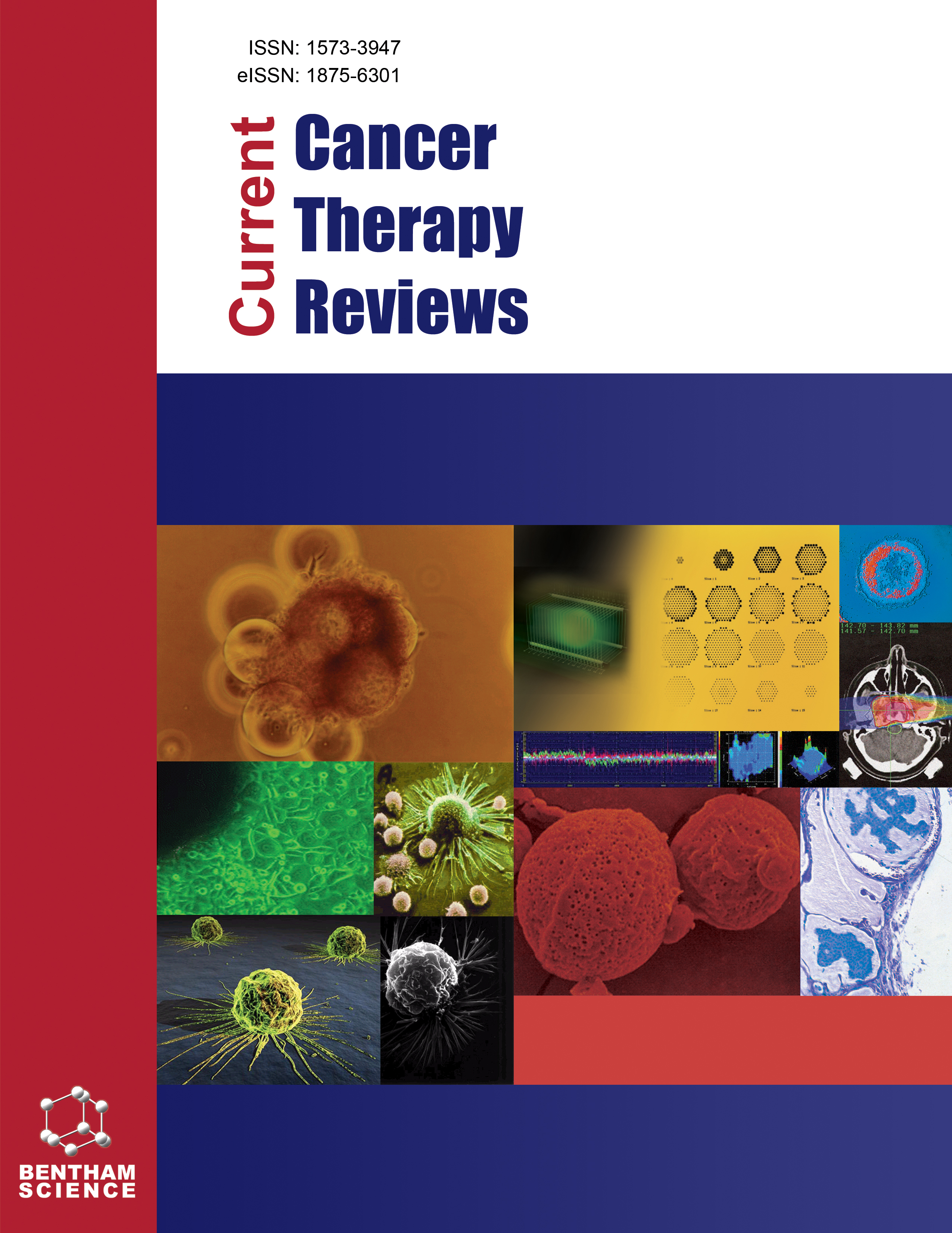- Home
- A-Z Publications
- Current Cancer Therapy Reviews
- Previous Issues
- Volume 16, Issue 4, 2020
Current Cancer Therapy Reviews - Volume 16, Issue 4, 2020
Volume 16, Issue 4, 2020
-
-
Exploring Nanoemulsion for Liver Cancer Therapy
More LessAuthors: Tanmay Upadhyay, Vaseem A. Ansari, Usama Ahmad, Nazneen Sultana and Juber AkhtarCancer is a leading cause of mortality worldwide, accounting for 8.8 million deaths in 2015. Among these, at least 0.78 million people died of liver cancer alone. The recognized risk factors for liver cancer include chronic hepatitis B virus (HBV) and hepatitis C virus (HCV) infection, exposure to dietary aflatoxin, fatty liver disease, alcohol-induced cirrhosis, obesity, smoking, diabetes, and iron overload. The treatment plan for earl Read More
-
-
-
MiR-492 as an Important Biomarker for Early Diagnosis and Targeted Treatment in Different Cancers
More LessRecent studies have led to a more detailed understanding of the roles played by microRNAs in health and disease, and their potential use as biomarkers in physiological and pathophysiological processes involving cancer initiation and progression. MiR-492 is encoded by a pseudogene, has a key role in some human cancer cells and its overexpression in tissues, and it has been proposed that it can be used as a good biomark Read More
-
-
-
Hepatoblastoma: Review of Pathology, Diagnosis and Modern Treatment Strategies
More LessAuthors: Adil A. Abbas, Alaa M.N. Samkari and Abeer S. AlmehdarHepatoblastoma (HB) is the most common primary malignant hepatic tumor of childhood and, occurring predominantly in the first two years of life. Approximately 100 cases are diagnosed every year in the United States of America. The management of HB has changed markedly over the last three decades. Alfa feto protein (AFP) and beta human chorionic gonadotrophin (beta HCG) are the main tumor markers and are marke Read More
-
-
-
The Important Role of Oncolytic Viruses in Common Cancer Treatments
More LessAuthors: Amir Mohamadi, Gilles Pagès and Mohammad S. HashemzadehOncolytic viruses (OV) are considered as promising tools in cancer treatment. In addition to direct cytolysis, the stimulation of both innate and adaptive immune responses is the most important mechanism in oncolytic virotherapy that finally leads to the long-standing tumor retardations in the advanced melanoma clinical trials. The OVs have become a worthy method in cancer treatment, due to their several biological adva Read More
-
-
-
Immunoliposomes: Synthesis, Structure, and their Potential as Drug Delivery Carriers
More LessAuthors: Divya Sandeep, Nour M. AlSawaftah and Ghaleb A. HusseiniImmunoliposomes have emerged as attractive drug targeting vehicles for cancer treatment. This review presents the recent advances in the design of immunoliposomes encapsulating a variety of chemotherapeutic agents. We provided an overview of different routes that can be used to conjugate antibodies to the surfaces of liposomes, as well as several examples of stimuliresponsive immunoliposome systems and their Read More
-
-
-
Drug Delivery Approaches for Doxorubicin in the Management of Cancers
More LessAuthors: Manish Vyas, Daniel A. Simbo, Mohd. Mursalin, Vijay Mishra, Roqia Bashary and Gopal L. KhatikAim: We aimed to review the drug delivery approaches including a novel drug delivery system of doxorubicin as an important anticancer drug. Background: Doxorubicin (DOX) is widely used against breast, uterine, ovarian, lung and cervical cancer. It is listed among the essential medicines by WHO and is thus a very important drug that can be used to fight against cancer. Despite its effectiveness, the use of the drug is limite Read More
-
-
-
Association of CA 15-3 and CEA with Liver Metastases in Patients with Breast Cancer
More LessAuthors: Akram Yazdani and Hossein AkbariObjective: The liver is the second most common site of distant metastasis from breast cancer that is usually associated with poor prognosis and low quality of life in breast cancer patients. Therefore, the primary diagnosis of liver metastatic lesions in breast cancer patients is very important. In this study, the ability of biochemical markers CA153, CEA, and ALP to be used for prognostic liver metastasis in women with breast canc Read More
-
-
-
Titanium Oxide Nanoparticles Improve the Chemotherapeutic Action of Erlotinib in Liver Cancer Cells
More LessBackground: Hepatocellular carcinoma is the second leading cause of cancer-related deaths among other types of cancer due to lack of effective treatments and late diagnosis. Nanocarriers represent a novel method to deliver chemotherapeutic drugs, enhancing their bioavailability and stability. Methods: In the present study, we loaded gold nanoparticles (AuNPs) and titanium oxide nanoparticles (TiO2NPs) with ERL to inv Read More
-
Volumes & issues
-
Volume 21 (2025)
-
Volume 20 (2024)
-
Volume 19 (2023)
-
Volume 18 (2022)
-
Volume 17 (2021)
-
Volume 16 (2020)
-
Volume 15 (2019)
-
Volume 14 (2018)
-
Volume 13 (2017)
-
Volume 12 (2016)
-
Volume 11 (2015)
-
Volume 10 (2014)
-
Volume 9 (2013)
-
Volume 8 (2012)
-
Volume 7 (2011)
-
Volume 6 (2010)
-
Volume 5 (2009)
-
Volume 4 (2008)
-
Volume 3 (2007)
-
Volume 2 (2006)
-
Volume 1 (2005)
Most Read This Month
Article
content/journals/cctr
Journal
10
5
false
en


